The Right Chimney Cap Can Protect Your Chimney & Save You Money
A functioning chimney has an opening at its top that allows smoke and fumes a clear ventilation path out of your home. That makes sense, right? You can’t have those chemicals lingering around your living space because they could affect your family’s health and increase the risk of a fire.
Still, having a hole at the top of your chimney seems like a flawed design. What if it rains or snows? What if leaves or twigs blow into the chimney? What about curious wildlife? Every one of these questions is valid, but there is a perfect solution to ease your concerns – a chimney cap. When installed and fitted correctly, a chimney cap is an essential part of a smoothly operating and leak-free chimney system.
Ozark Stove & Chimney offers chimney cap installation and repair services throughout the Southwest Missouri and Northwest Arkansas area all year round. If you live in Benton County, Greene County, or anywhere else nearby, reach out today.
What Is a Chimney Cap?
A chimney cap is a small covering that sits at the very top of a chimney flue right above the crown. It is usually made of metal, and it acts as a barrier against rain, snow, critters, debris, and anything else that tries to enter your home through the chimney opening.
You may be wondering how smoke can escape a chimney with a cap? In most cases, chimney caps come with mesh siding that allows all of the toxic exhaust to exit freely, while still protecting your home from natural elements.
What Does a Chimney Cap Do?
The primary function of a chimney cap is to act as a shield between your home and the outdoors. However, chimney caps are multipurpose and are important to the overall efficiency of your chimney system. What exactly does a chimney cap do?
It Keeps Water Out
Water is enemy number one for chimneys. During rain, snow, and other weather events, water can enter your chimney flue and set off a chain of events that can impact several parts of your chimney system and make your chimney unsafe to use. Like what?
- Brick is naturally absorbent and when water seeps into brickwork, it can eventually cause brick spalling and chipping mortar if left untreated.
- If water enters the flue, it can lead to the deterioration of the flue liner, which can increase the risk of fires and gas leaks.
- Water can damage different chimney components and metal parts, like the damper, which keeps them from functioning properly.
- Then there’s mold; water instigates the growth of mildew and mold, leading to foul odors and potential health hazards.
In the end, keeping water out is a must – cue the chimney cap.
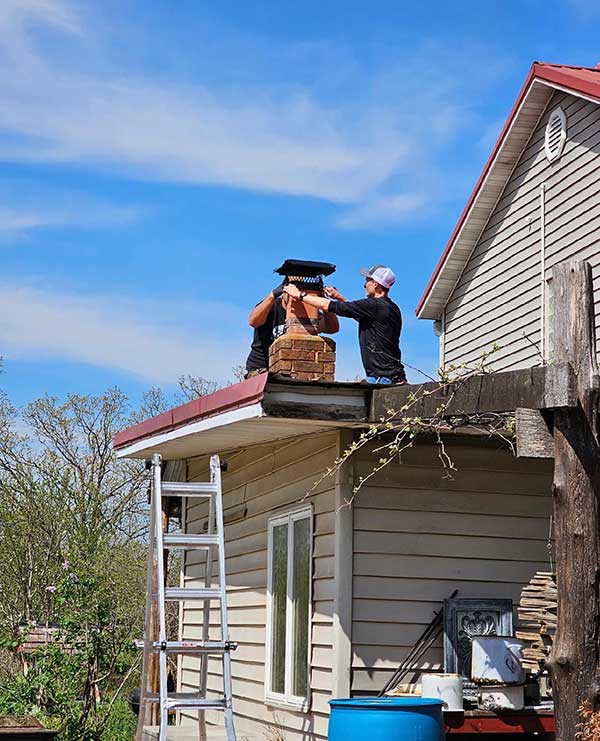
It Serves As a Spark Arrestor
A spark arrestor is a device that guards against the emission of flammable debris from combustion sources – and your chimney cap can act as one to protect your roofing materials.
Temperatures inside a wood-burning fireplace or wood stove can hit well over 1100° Fahrenheit. This type of intense heat combined with combustible gases can send hot embers and sparks out the flue. The cap’s metal body can put these embers and sparks out well before they get the chance to land on your roof, nearby trees, or flammable materials on the ground, thereby preventing fires.
It Prevents Debris From Entering
We live at the mercy of weather that can change and become severe in an instant. There is nothing you can do to stop a bad storm from knocking over a tree or dislodging a branch onto your property, but you can take precautions to keep it from blowing debris into your chimney. A chimney cap is a safeguard that keeps leaves, twigs, needles from surrounding trees, and other random debris from falling into your flue and clogging it up.
It Ensures No Critters Are Allowed In
When not in use, chimneys are dark, quiet, and contained spaces. For birds, squirrels, bats, and other little critters, a chimney is a perfect nesting spot away from the threat of predators. Bees and hornets are also common pests found in chimneys and can build intricate hives that span the length of your flue.
Aside from the biological hazards they present, animals leave behind nesting materials and waste that can be flammable or a health hazard. One spark can cause a chimney fire that would cost you significant money in repair work. A chimney cap will deter wildlife and protect you from any unwanted roommates or an insect infestation.
It Encourages Proper Ventilation
How a chimney cap is designed can impact the chimney’s draft. A draft is the upward flow of air that helps remove smoke, gases, and other byproducts of combustion from the fireplace, furnace, or wood stove. A well-designed chimney cap can create a vacuum effect that aids in the upward movement of air, improving the draft and overall ventilation of the chimney.
It Prevents Downdrafts
When heavy winds swoop across your rooftop, this can lead to downdrafts entering your home through the chimney – talk about unpleasant. This can also lead to smoke or carbon monoxide coming back down into your living space, filling the house with smoke, foul odors, and other toxins. A properly installed chimney cap should effectively block downdrafts.
It Can Improve Home Energy Levels
Installing a chimney cap can help lower your utility costs by improving your home’s energy efficiency levels. While the damper in your chimney is intended to keep out drafts, many dampers (especially throat dampers) don’t have a tight enough seal to do the job very well. A chimney cap with a top-sealing damper can stop air leakage, keeping your home cooler in the hot months and warm during cold periods.
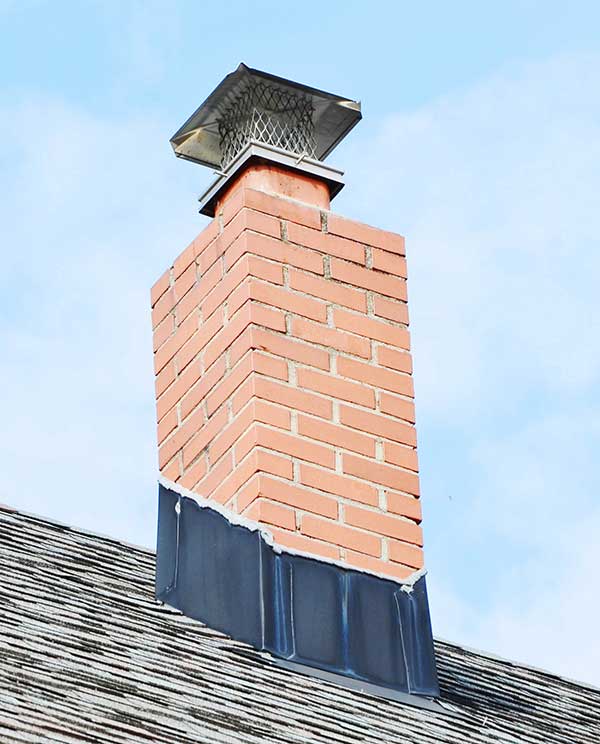
What Is the Difference Between a Chimney Crown & a Chimney Cap?
The terms “chimney cap” and “chimney crown” are sometimes – mistakenly – used interchangeably. While they do work in unison to keep your chimney system working efficiently, they are distinctive components.
- The chimney cap is mounted on top of the flue vent or crown and helps prevent water, birds, small animals, and debris from getting inside the flue.
- The chimney crown is a sloped surface usually made of mortar or cement that sits atop your chimney. The sloped shape directs water away from your chimney, protecting the external masonry.
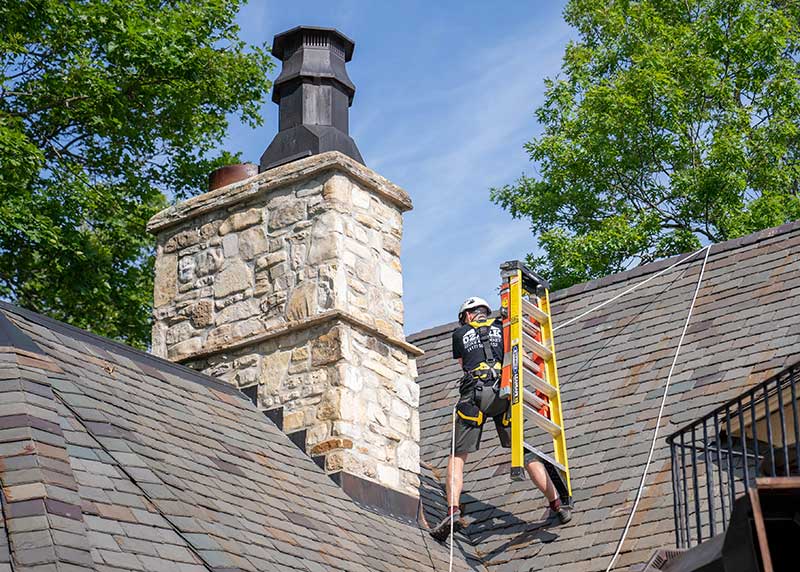
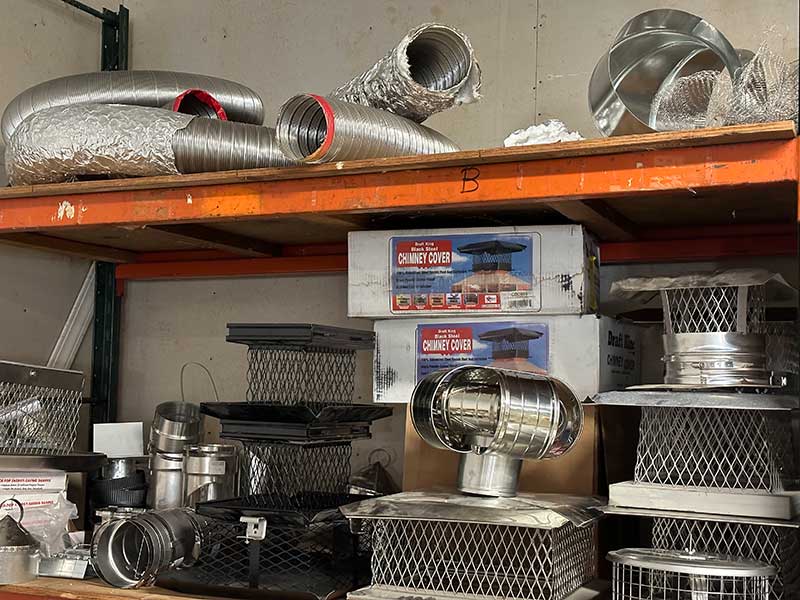
Are There Different Types of Chimney Caps?
Chimney caps may seem straightforward but there is no one-size-fits-all chimney cap on the market. With so many materials and shapes available, there are a lot of options to ensure your chimney is fitted with the right model for your unique needs.
Chimney caps can be made of galvanized steel, stainless steel, aluminum, and copper. There are also specialty caps that are designed to address specific issues which could be more useful to you depending on where you live. For instance, if you live in an area with high winds, a wind-resistant chimney cap that prevents downdrafts is probably best for your home. Or if you live in an area that is often subjected to severe bouts of rain or snow, a rain cap will likely be your best bet.
Different caps provide different benefits and downsides. These are some common types of chimney caps used during installation:
- Mesh, single-flue caps are the most popular chimney caps. The mesh prevents animals, birds, and debris from entering the flue, while still allowing smoke and gases to escape freely.
- Multi-flue caps are designed to cover chimneys with multiple flues. They may need to be custom-made to fit the specific size and orientation of the multiple flues.
- Decorative caps are designed with the curb appeal enthusiast in mind. They are functional, but tend to feature certain elements to enhance your home’s appearance and are more ornate than standard chimney caps.
- Rain caps are also known as chimney rain covers. They are designed with a sloped top that redirects water away from the chimney.
- Spark arrestor caps feature a mesh screen that catches and extinguishes sparks and embers before they can land on a flammable surface.
- Wind-resistant caps are specifically designed to prevent downdrafts caused by strong winds.
Not sure what you need? Request an appointment with us online or simply give us a call to discuss your options.
Will a Chimney Leak Without a Cap?
In short, yes. Even if you waterproof your chimney and have an intact chimney crown, a chimney cap prevents rain and other precipitation from entering your flue and damaging the interior chimney. Eventually, untreated water damage can lead to a leaky chimney and structural damage to the flue liner. Water can also cause rust to form on other chimney components which makes them weaker and more vulnerable to damage.
So, if you’re wondering whether or not a cap is actually necessary… it is!
How Often Do Chimney Caps Need To Be Replaced?
Stainless steel and copper chimney caps should hold up for many decades with proper maintenance. In most cases, a ferrous metal chimney cap will last for 5 to 6 years, depending on the material surrounding weather conditions.
With that said, it is important to have your chimney inspected annually by a technician certified through the Chimney Safety Institute of America (CSIA) – like us. Trained technicians are able to assess chimneys and can advise you early on of suspected problems, potentially saving you the cost of repairing or replacing a chimney cap. Regular chimney sweepings to clear debris that has collected around your chimney cap will also add to its longevity.
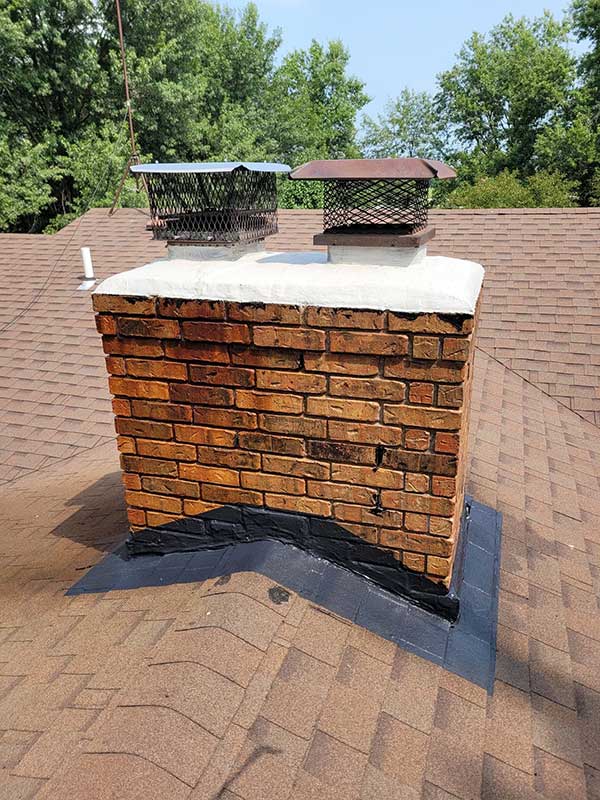
Can I Install a Chimney Cap Myself?
As a homeowner, it is often tempting to take a do-it-yourself approach to home repairs and maintenance. Hiring a chimney professional can mean costly labor and materials. It is, then, completely logical to believe that taking matters into your own hands is an easy way to save on expenses… Or is it?
For a chimney cap to work as it is intended, it needs to be fitted to your chimney’s specifications and installed correctly. If your measurements are off or the chimney cap is not properly sealed, water will seep into your chimney, deeming all that work you did null and void – and you’ll likely need expensive and time-consuming repairs down the line. Consider the professional installation of a chimney cap as an investment that will save you money (and stress) in the future.
In addition, from a safety perspective, chimney professionals are outfitted with the most up-to-date personal protection gear, including helmets, respirators, and harnesses. Working on roofs is inherently dangerous. As professionals, we understand the risks involved and are completely prepared.
How Much Does a Chimney Cap Cost?
Chimney caps are relatively inexpensive to purchase, but, as with most work of this nature, there are a lot of variables that can impact total cost and influence the bottom line. Things like:
- the type of materials used
- installation time
- chimney cap type
- the size of your chimney
- …and more
For example, if your chimney is a unique shape, you may require a custom chimney cap that requires more labor. Or if you have multiple flues, that’ll be more costly than having a single-flue cap installed.
Not sure where to start? Finding the process a bit overwhelming? No worries. The chimney professionals here at Ozark Stove & Chimney are experts in the chimney business and we’re happy to discuss your options with you. We can walk you through the different types of chimney caps and the expected cost of installation, then discuss which style options would work best for your home.
Together, we are confident that we can come up with a solution that suits your needs and budget. Reach out today.
Schedule an Appointment With Us Now
If you need a chimney cap installed or repaired, reach out to Ozark Stove & Chimney as soon as possible. One of our customer service representatives will be happy to answer any questions you may have and get you set up with one of our CSIA-certified technicians. Leaky chimneys are no match for our experienced and friendly crew!
Give us a call at 417-201-6585 or visit our website to schedule an appointment online. We can’t wait to speak with you soon.
If your chase cover is doing its job, it can help decrease the need for leaky chimney repairs. Ask us to take a look.
